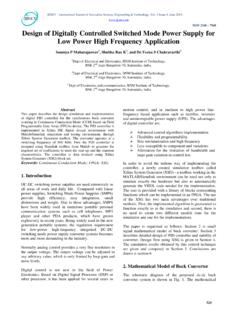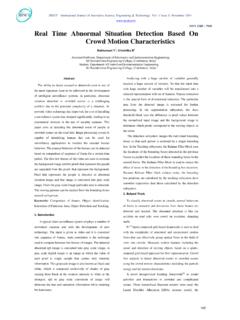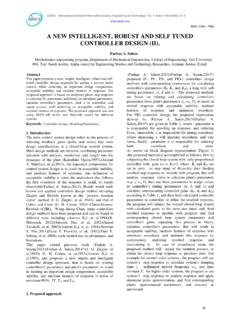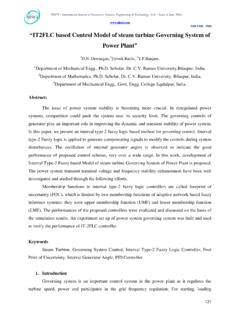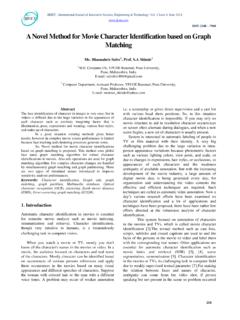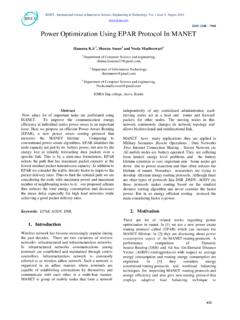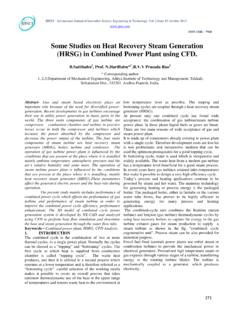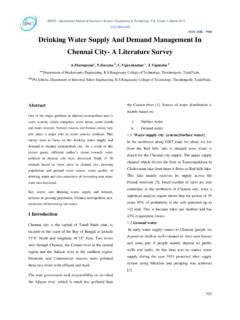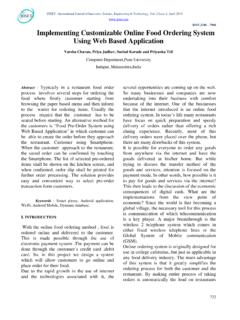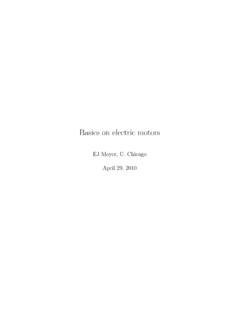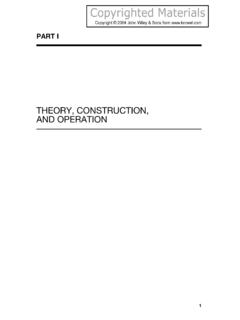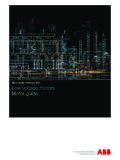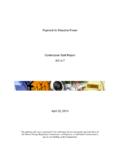Transcription of A Survey on Low-Voltage Ride-Through …
1 IJISET - International Journal of Innovative Science, Engineering & Technology, Vol. 1 Issue 6, August 2014. ISSN 2348 7968. A Survey on Low-Voltage Ride-Through Techniques for DFIG. based Wind Turbines and 1. Department of EEE, Anna University/Sri Krishna College of Engineering and Technology, Coimbatore-641038, Tamil Nadu, India 2. Department of EEE, Anna University/Sri Krishna College of Engineering and Technology, Coimbatore-641038, Tamil Nadu, India Abstract system with a multi-stage gearbox and a doubly fed The Doubly-Fed Induction Generator (DFIG) is the most widely induction generator (DFIG) and (iii) variable speed system used technology in wind turbines worldwide.
2 The reaction to grid with gearless wind turbine system with a direct-drive voltage disturbances is sensible in case of DFIG systems. Fault generator. The statistics of the installed capacities of wind ride through (FRT) is an important feature for wind turbine farms worldwide is shown in systems to fulfil grid code requirements. This is one of the biggest challenges resulting in a massive deployment of wind farms. During a fault condition, the voltage at the Point of Common Coupling (PCC) drops immediately and the grid voltage reduces ( voltage sag) imposed at the connection point of the DFIG to the grid induce large voltages in the rotor windings, resulting in high short circuit current, which can damage the rotor-side converter and disconnect from grid.
3 This paper presents the various techniques to enhance the fault ride through capability of DFIG wind turbine. Keywords: Wind Turbine, Doubly-Fed Induction Generator (DFIG), Grid code requirements, Low-Voltage Ride-Through (LVRT). 1. Introduction Global installation capacity of Wind Turbines Global warming has been attributed to the increase of the atmospheric gases concentration produced by the burn of Among the wind turbine technologies, the turbines using fossil fuel. Wind power generation is an important doubly fed induction generator (DFIG) are the most alternative to mitigate this problem mainly due its smaller widely used ones due to its variable-speed four-quadrant environmental impact and its renewable characteristic that operation, its controllable capability of both active and contribute for a sustainable development.
4 Three factors reactive power separately, and its partially (30%) rated have made wind power generation cost-competitive, these power converter [3]. But the DFIGs are too sensitive for are: (i) the state incentives, (ii) the wind industry that have grid voltage disturbances, for symmetrical and improved the aerodynamic efficiency of wind turbine, (iii) unsymmetrical voltage sags, that may damage rotor side the evolution of power electronics and new control converter and hence it requires additional protection for methodology for the variable-speed wind turbine, that the rotor side power electronic converter. This paper allows the optimal performance of wind turbine.
5 Describes the conventionally used and new technologies for the Low-Voltage ride through capability for wind The development in the wind energy conversion turbine systems employing Doubly-Fed Induction technology has been rapidly increasing from the past two Generator. decades. There are basically three types of wind turbine technologies used for power generation [1]. They include: 2. Doubly-Fed Induction Generator (i) fixed-speed wind turbine system using a standard squirrel-cage induction generator (SCIG), directly DFIGs (Doubly-Fed Induction Generators) are variable connected to the grid. (ii) variable speed wind turbine speed generators with advantages compared to other 570.
6 IJISET - International Journal of Innovative Science, Engineering & Technology, Vol. 1 Issue 6, August 2014. ISSN 2348 7968. solutions. They are used more in wind turbine applications 3. Grid Code Requirements due to its easy controllability, improved power quality and high energy efficiency. Fixed speed generators and Increasing wind power penetration levels to the power induction generators had the disadvantage of having low systems of many regions and countries has led to the power efficiencies at most speeds. To improve the elaboration of specific technical requirements for the efficiency, controlled power electronics converters are connection of wind farms to the grids.
7 These requirements commonly used. voltage source inverters are used to are concerned with grid codes issued by the system convert the voltage magnitude and frequency to match the operators . The grid codes specifies that wind farms grid values. should contribute to power system control (frequency and also voltage ), much as the conventional power generation The DFIG wind turbine system is shown in The stations, and withstand on wind farm behaviour in case of drive system operates in four quadrants. This implies that abnormal operating conditions of the network (such as in a bidirectional flow of power both in sub-synchronous and case of voltage dips due to network faults) [4].
8 Grid code super-synchronous speed [2] is possible. The possibility of requirements have been a major driver for the supplying and consuming reactive power enables the development of Wind turbine (WT) technology. generator system to act as a power factor compensator. By the control of the back to back inverters, the control of the The grid code requirements typically refer to large wind slip is made easy. In the case of the squirrel cage induction farms connected to the transmission system, rather than machine, as the rotor cannot be driven, the slip depends smaller stations connected to the distribution network. The only on the stator and load inputs.
9 Most common requirements include FRT capability, extended system voltage and frequency variation limits, active power regulation, power factor correction, frequency control, as well as reactive power and voltage regulation capabilities. 4. Fault Ride-Through Capability- Topologies Even though DFIG wind turbine has several advantages, it faces two major problems. Firstly, it is very sensitive to voltage disturbances especially voltage dips (sag). If any fault occurs in the grid, there will be a very large voltage disturbance which leads to uncontrollable current in the rotor side converter that results in the damage of the power electronic switches.
10 Secondly DFIG suffers from output power fluctuations [5]. DFIG Wind Turbine System As for synchronous machines, a relatively large torque may cause the machine to oscillate. The DFIG does not pose any synchronization problems. The rotor circuit is connected through slip to the back to back converter arrangement controlled by PWM strategies. Back to back converters consist of two voltage source converters (ac-dc- ac) having a dc link capacitor connected in between them. The generator side converter takes the variable frequency voltage and converts it into dc voltage . The grid side converter gets the ac input voltage from the dc link and voltage at grid parameters as output.
